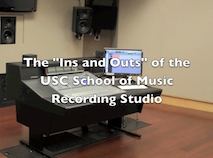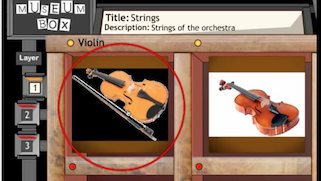-

Artifact: The Ins and Outs of the USC School of Music Recording Studio
Context: This instructional video was created in Fall 2010 as a part of EDET 603 Design and Development Tools I. One of the biggest difficulties new recording engineering students face is their first projects working in the recording facility in the USC school of Music. While the task may be a basic one, the students need to be able to operate a fairly complex recording facility to complete it. This is similar to having a student to make an in-flight announcement - an easy task, unless they have to pilot the plane as well!
As is common when dealing with technology, students can become frustrated and distracted from the actual task by problems they encounter. This video was designed to serve as a scaffold to assist during their first times in the recording studio. Since it is available on the internet, they can access it exactly when they need the assistance.
Conditions: The instructional video incorporates still images, video, graphics, screen captures, screencasting, narration, and music as a cohesive whole. Video was constructed in iMovie, with additional materials created using EasyDraw, Preview, Jing, CaptureMe, and EasyWMV.
Scope: Video is available on YouTube. It is utilized as a supplemental text by students in MUSC 365 Introduction to Audio Recording. Development, storyboards, and reflections can be seen on the development wiki.
Role: I am the sole creator of the video content, images, and interactive diagrams. Some photos by Matt Francis, courtesy of Matt Francis Photography.
ADDIE: For a project of this complexity, organization and planning is vitally important. Analysis included specific goals, outcomes, a content outline. Design and development followed a content flowchart and storyboard. Formative evaluation occurred and was reflected upon during the process, but the true rewards came as I provided the finished video to my students. This scaffold enabled them to progress thru their recording projects with little frustration and far less distraction from the actual learning that needed to take place.
Performance indicators:
2.0.2 Use appropriate analog and digital productivity tools to develop instructional and professional products.
2.0.3 Apply instructional design principles to select appropriate technological tools for the development of instructional and professional products.
2.2.1 Apply principles of visual and media literacy for the development and production of instructional and professional materials and products. Design and produce computer-based technologies that include or use Audio/video, digital, imaging devices, authoring tools, and telecommunication tools.
Appropriate media was chosen for each step in the instructional video. Live video of someone operating a piece of equipment cuts to a screen snapshot with a graphic overlay highlighting the important items. In another section, screen captures zoom in to essential elements. Over all of it, narration directs the learner.
2.2.2 Apply development techniques such as storyboarding and or scriptwriting to plan for the development of audio/video technologies.
A full storyboard was developed and followed during the creation of this instructional video.
2.4.2 Develop and prepare instructional materials and products for various distance education delivery technologies.
Though used as part of a course that has a traditional meeting time, this video is designed and implemented for distance delivery. Students are able to access the video in YouTube at any time and from any location where they have internet access. Many of them view the material on their smart phone during a recording session setup as they move from studio to control room.
Top
-

Artifact: Museum Box Staff Development Program &
Example VideoContext: This professional development training was developed for EDET 746: Management of Technology Resources in the fall of 2011. Training materials on the use of Web 2.0 tool Museum Box were developed and presented to teachers at Bluffton Elementary and Early Childhood Center.
Conditions: This group project involved the creation and implementation a staff development program. The training program involved online videos and supplementary materials presented via a wiki. An onsite facilitator was also used for introduction and evaluation.
Scope: The staff development program is available on the Museum Box wiki.
Role: For the stages of the instructional design process I worked collaboratively with the group as a whole, providing direction about the ADDIE process and specific deliverables. I was solely responsible for the second session of the training program and the screencasts for that session.
ADDIE: The group progressed directly thru the ADDIE process, using Dick & Carey’s Systems Approach Model as our guide. This allowed us to implement constant revisions throughout the design, development, and implementation. The ADDIE steps can be seen in detail via these reports: Analysis, Design, Development, and Evaluation. (PDF, 62-149kB, opens new window)
Performance indicators:
2.0.5 Apply appropriate evaluation strategies and techniques for assessing effectiveness of instructional and professional products.
2.0.6 Use the results of evaluation methods and techniques to revise and update instructional and professional products.
The staff development program incorporated formative, summative, and learner evaluation. Formative evaluation was in the form of two surveys, the results (PDF, 256kB, opens new window) of which can be seen in PDF form. Summative evaluation rubrics were developed, but the evaluation itself was not completed with the time frame of the training.
2.2.2 Apply development techniques such as storyboarding and or scriptwriting to plan for the development of audio/video technologies.
Each training video was initially developed as a storyboard before the screencasts were created.
Top
-
Go to the Utilization Artifacts page.

This work is licensed under a Creative Commons Attribution-NonCommercial-NoDerivs 3.0 Unported License.